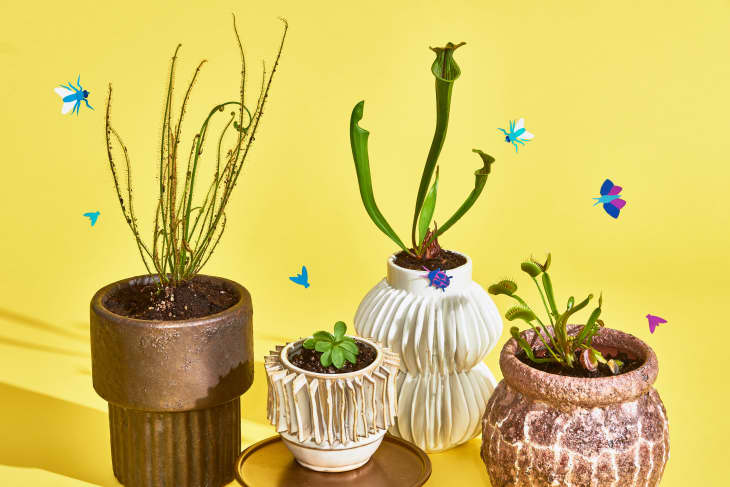If you’ve ever seen the cult classic film Little Shop of Horrors, you might have a hard time shaking the feeling that carnivorous plants are out to get you while you sleep. But it’s time to put those images of creepy, singing, human-swallowing alien plants out of your head for good, because meat-eating plants are a beautiful, interesting, and entertaining addition to your houseplant collection.
What Are Carnivorous Plants?
You know all plants make their own food through photosynthesis, so you might be wondering why some plants adapted to eat protein—mainly insects, but occasionally small frogs and mammals—in the first place. Carnivorous plants are found all over the world in boggy environments. Bogs are high on water and low on nutrients (which tend to get washed out of the soil), so these plants evolved to make up for the lack of soil nutrients (nitrogen in particular) by catching their own dinner.
Carnivorous plants lure their prey into their leaf-traps with sweet smelling nectar, bright colors, and tiny little leaf hairs. Once captured, they break down the flesh with their digestive enzymes, extracting the nutrients.
Carnivorous Plant Care Tips
Caring for carnivorous plants is a little different than caring for your other houseplants. They require some special considerations because of their unique natural habitat. Here’s what you need to know before adopting one.
Carnivorous Plant Soil
Because carnivorous plants are naturally bog-dwellers, they prefer continuously wet, well-draining soil. For your best chance of success success, plant your carnivorous plant in a 50/50 mixture of sphagnum peat moss and coarse sand.
Note: Mostly all of the sphagnum peat moss sold in the U.S. is mined from peat bogs in Canada. It’s formed as the moss decomposes over several millennia beneath the bog’s surface without the presence of air. It’s great at retaining water and is naturally acidic, which carnivorous plants prefer. Unfortunately, it’s also a nonrenewable resource since it forms so slowly, and mining it releases a lot of carbon into the atmosphere, so it’s best to use it sparingly and only for plants that require it.
Water
Keep the pot in a saucer filled with water to prevent the roots from drying out (this is really important!). Water carnivorous plants using only distilled water or rainwater; tap and spring water contain a lot of minerals that your little meat-eater won’t appreciate. Most carnivorous plants also tend to do well in terrariums because they like high humidity.
Sun
Bright sun is best, so keep carnivorous plants in a south-facing window. If you have a balcony or patio, outdoor growing is also an option. Do your best to protect them from drafts and the hot dry air of heating vents in cooler weather (dedicated plant parents should consider closing the vent if it blows directly on the plant). All of the plants mentioned below (with the exception of some sundew varieties) go dormant during the winter, so move them to a cooler location and out of bright light from November to mid-February.
Feeding
Now, for the most fun part. If you are growing your carnivorous plant indoors and your apartment is not filled with insects—and we hope it’s not!—it may need a bit of help catching its meals. You can certainly feed it any flies or other insects you happen to squash, but if you’re in short supply, pick up a jar of bloodworms from the pet store (they’re sold as fish food). As a general rule, don’t feed your plant more than one insect per week.
Best Carnivorous Plants for Beginners
Ready to get started? Here are some of the more common and easy-to-grow carnivorous plant varieties.
Venus Flytrap
The venus flytrap is, of course, the most famous of carnivorous plants. It has hinged leaves shaped like an open coin purse that clamp shut over their prey, which they lure inside with a sweet-smelling nectar. The leaves are lined with teeth-like fibers that trigger an electric charge when touched, causing the leaves to close up. Digestive enzymes break down and absorb the victim’s tissues. The trap reopens once this process is complete, after about a week. When feeding your venus flytrap dead insects, tickle the hairs a bit with a toothpick to simulate the feeling of a moving insect in order to trigger the trap to close.
Pitcher Plant
Pitcher plants (Sarracenia) come in a variety of yellow, pink, and purple shades. They have upright tubular leaves, and any insects unfortunate enough to fall into their depths become the plant’s next meal.
The best choice for indoor growing is Sarracenia purpurea, or purple pitcher plant. Bright light is especially important for pitcher plant, so you may need to supplement your natural light with a grow light. Terrariums are not ideal for pitcher plants.

Butterwort
Butterwort is a small plant with soft yellowish-green leaves that bears pink, yellow, purple, or white flowers in spring. It has a more subdued look than venus flytrap and pitcher plant, but it is just as deadly to unassuming insects: Its leaves have a sticky resin that keeps them from flying away.
Sundews
Sundews are covered in fiery orange hair-like filaments that are covered in a sticky substance that both traps and digests insects. Once an insect is trapped, the arms fold in on themselves until digestion is complete.
Hải Yến
Gió bạn với cây tự buổi nào ,
Gió về cây lại ngất ngư chao .
Gió đi cây sẽ im lìm đứng,
Như kẻ lỡ làng dạ khát khao .
Hải Yến
Gió bạn với cây tự buổi nào , Gió về cây lại ngất ngư chao . Gió đi cây sẽ im lìm đứng, Như kẻ lỡ làng dạ khát khao .



